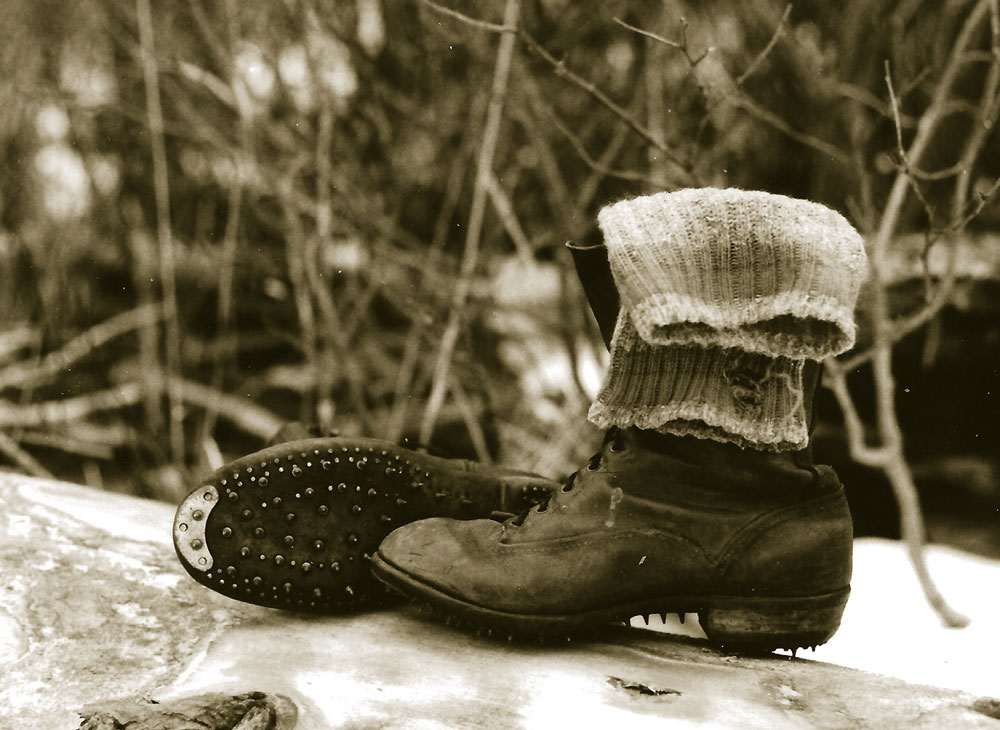The following is a compilation of stories collected by Upstate New York folklore enthusiast, Howard Thomas, and published in Folklore from The Adirondack Foothills (Prospect Books, 1958). It appears here with the permission of Bob Igoe, president and owner of North Country Books.

Article Printed in “The Northern Logger”, Sept. 2023
BY HOWARD THOMAS
The following is a compilation of stories collected by Upstate New York folklore enthusiast, Howard Thomas, and published in Folklore from The Adirondack Foothills (Prospect Books, 1958). It appears here with the permission of Bob Igoe, president and owner of North Country Books.— William J. O’Hern

One afternoon in May 1909, Mrs. Lowell Odit was hanging up clothes behind her home overlooking Wilmurt Falls on the West Canada when she heard a cry for help rise above the roar of the creek. Looking upstream, she saw a man riding a log. As she watched, the log rolled and threw its rider into the water. He rose to the surface and clutched the end of the log.
“Low!” Mrs. Odit cried to her husband, “There’s a man in the creek above the falls. He’ll go over them for sure.”
Low rushed to his wife’s side as the man cried, “Goodbye. I got to go!” and was carried over the falls into the pond which backed up water for Richards’ mill. The Odits gasped in amazement, for Wilmurt Falls had always been considered a death trap, but the log had picked the one course possible to get the man through. The danger was far from over, for a second fall at the mill dam would undoubtedly prove fatal.
“It’s Muggins Laird,” gasped Low. “He ain’t no swimmer.” He carried a long board to the creek’s edge and stretched out on his stomach on an overhanging hemlock where he could push the board within reach of the man in the water.
“Swim a little, Muggins,” cried Low.
“I can’t. I’m all numb and can’t move.”
Odit coaxed Muggins’ log with his board and drew it toward him until he could get a hold on Muggins’ shirt.
Slowly, but surely, he got Muggins to shore and to the house, where the riverjack warmed himself, had a cup of strong coffee, and marched back up the river in his wet clothes, thankful that he had received no more than a bad ducking.
Rivermen wore heavy woolens, so they were not afraid of a spill into the water. Nor did the fact that many of them could not swim a stroke deter them from taking chances with dangerous rapids. The men were joking with George Dolly, a husky, two-hundred-pounder who had little skill with the peavey and was unable to swim. Dolly, tired of the joshing, bet the others ten dollars he could get down through a particularly rough stretch of “white water” unscathed. The men tried to dissuade Dolly, but they covered his money.

Dolly picked up a peavey and jumped onto a log, which he pushed toward the rapids. He lasted one split second. Soon he was thrashing around like a walrus as the current carried him downstream. Watchers along the shore could see first an arm, then a leg, and occasionally Dolly’s head. They felt sure the big fellow was riding to his death. Dolly had other ideas. He eddied around in the swirling water and rolled and tumbled to shore to receive his ten dollars.
One of the most daring river rescues took place near the bridge at McKeever, in April 1914. John B. Todd, superintendent of the Gould Paper Company drive, had already saved one man from going over a fall below the bridge by throwing him a rope and drawing him to the boom above the fall. His boss riverman, Jim Haley, was destined to perform a greater miracle.
Heavy rains had caused logs to jam against the McKeever Bridge piers. More logs tumbled against them, with the result that the jam resembled a huge game of jackstraws with the Moose River racing beneath it. Riverjacks were sent out with peaveys to loosen some logs from the mass and send them into the rushing current.
When the jam broke with a roar, Jack McGee, a green hand, was unable to leave the logs. The other jacks saw his peril and yelled for him to run up the jam. Instead, he became panic-stricken and did nothing.
Jim Haley, who was standing on the bridge, yelled for McGee to lie down on the logs, with the hope that he would pass under the bridge safely. McGee chose one log instead of two or three. He was swept under the bridge and into the river.
Haley heard the cry, “He’s in!” He grabbed a peavey, leaped from the bridge to a dancing log, dug his “corks” [caulks, or boot cleats] in, balanced himself, and jumped from log to log in McGee’s direction. When he had overtaken the drowning man, Haley sank his peavey into his log, braced himself, and drew McGee out of the water. Holding the almost unconscious man over his knees, he directed the log to shore and safety.